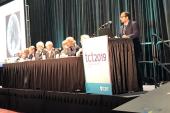STEMI Patients With In-Hospital Cardiac Arrest Bear Outsize Mortality Burden
Though seen in just 2.2% of STEMI patients, ICHA was responsible for 55% of inpatient deaths in a Chinese registry.

STEMI patients who develop in-hospital cardiac arrest (IHCA) face far worse survival than those who don’t have the condition, but new observational data from China suggest several steps that might reduce IHCA from happening in the first place.
Strikingly, the researchers found, inpatient mortality was 53% in STEMI patients with IHCA versus 1.0% in those without IHCA during the index hospitalization.
Senior author Shaoping Nie, MD, PhD (Beijing Anzhen Hospital, Capital Medical University, China), pointed out to TCTMD that most studies and guidelines in STEMI have focused on out-of-hospital cardiac arrest (OHCA). Yet some evidence has shown IHCA carries higher mortality than OHCA “even though patients with IHCA can have faster access to resuscitation resources,” said Nie.
The results, from the CCC-ACS (Improving Care for Cardiovascular Disease in China-Acute Coronary Syndrome) Project, were published today in the Journal of the American College of Cardiology. The project is a collaboration between the American Heart Association and the Chinese Society of Cardiology aimed at optimizing ACS care across China.
“Our study suggested that IHCA is rare in STEMI but is associated with high mortality,” Nie said in an email. “IHCA may be preventable by early intervention and rational drug treatment and thereafter improve in-hospital outcomes for STEMI patients.” Their study is the first, Nie added, to explore a wide range of modifiable and unmodifiable risk factors for IHCA in the STEMI setting.
Umesh Khot, MD (Cleveland Clinic, OH), commenting for TCTMD, said the results speak to larger shifts in STEMI care and outcomes.
“We’re learning more that the nature [of] how people die with ST-segment myocardial infarction has changed,” said Khot. What’s interesting, he continued, is that while IHCA “is rare, it drives a large amount of the death and so it has this disproportionate impact.”
In today’s practice, the average “person who comes in with STEMI now has a very low risk of dying and is often out of the hospital in 48 to 72 hours,” he noted, and the “routine care of STEMI has become very straightforward.”
We should really try to achieve the best care process even in these patients who are likely more complex, more difficult, more challenging. Umesh Khot
Still, there’s this small slice of patients who have quite high mortality, leaving room for improvement, Khot said.
Ticagrelor, Beta-blockers, and Primary PCI
Led by Wei Gong, MD, PhD, and Yan Yan, MD (both from Beijing Anzhen Hospital, Capital Medical University), the researchers looked at 40,670 STEMI patients enrolled in the CCC-ACS project between 2014 and 2019, all of whom presented within 24 hours of symptom onset.
Within this group, 2.2% developed IHCA. The condition was an important contributor to mortality, representing 55% of inpatient deaths in the STEMI cohort. Although the risk of IHCA dropped slightly over the study period, the mortality rate held steady.
Nine patient- and disease-related characteristics predicted IHCA: age 75 years or older (HR 2.24; 95% CI 1.94-2.58), female sex (HR 1.37; 95% CI 1.18-1.60), not smoking (HR 1.23; 95% CI 1.05-1.43), prior diabetes mellitus (HR 1.37; 95% CI 1.17-1.59), prior renal failure (HR 1.68; 95% CI 1.12-2.54), heart rate above 100 bpm (HR 1.62; 95% CI 1.38-1.91), systolic BP < 90 mm Hg (HR 1.50; 95% CI 1.23-1.83), Killip class IV (HR 2.43; 95% CI 2.03-2.91), and—most notably—prior OHCA.
Nie pointed out that 40.3% of patients in this study who experienced IHCA had already had an OHCA. Among those, the risk of developing IHCA was 21 times higher than those with no previous event. “These findings suggest that patients with OHCA should be carefully monitored for the risk of further IHCA,” he said.
STEMI patients with IHCA were less likely than those without IHCA to receive beta-blockers (44.9% vs 56.6%) and ticagrelor (28.0% vs 42.3%), as well as less likely to undergo primary PCI (59.4% vs 71.8%; P < 0.01 for all). Use of three treatments predicted a lower risk that patients would develop IHCA.
Modifiable Risk Factors for IHCA in STEMI Patients
|
|
Adjusted HR |
95% CI |
|
Ticagrelor Use |
0.57 |
0.42-0.76 |
|
Beta-blocker Use |
0.63 |
0.47-0.86 |
|
Primary PCI |
0.82 |
0.71-0.95 |
Within the subset of 29,447 patients who underwent primary PCI for STEMI, 1.8% developed IHCA. Compared to those who did not have IHCA, those who did were more likely to present with left main disease, less likely to receive radial access, and more likely to be supported by intra-aortic balloon pump.
Nie acknowledged that with an observational study, it’s hard to rule out possible confounding. Future work is needed to confirm these findings, optimize early treatment to prevent IHCA, and clarify IHCA risk factors in the NSTEMI setting, he added.
Khot pointed out that the treatments that seem to prevent IHCA are “things that are fairly standard, that we’re wanting to do in all patients.” The fact that these treatments were less often used in the IHCA group highlights the need to minimize care variability, which could decrease not only the risk of the condition itself but also the risk of mortality.
And while the use of primary PCI was lower in China than in the United States, the same factors that might be expected to influence IHCA risk matches up well between the two countries, said Khot. “I think this is actually a nice unifying way of looking at things across the world in terms of STEMI.”
For Khot, a key question going forward is: “Can this gap in care for these patients be closed?” When door-to-balloon time first emerged as a quality metric for STEMI, for example, patients with cardiac arrest were often excluded from that measure, he noted. This study’s perspective, on the other hand, “is that every patient should matter, and we should really try to achieve the best care process even in these patients who are likely more complex, more difficult, more challenging.”
Like Khot, Graham Nichol, MD, and Amanda West, MD (both from University of Washington, Seattle), agree in an accompanying editorial that STEMI care has come a long ways.
“Clinicians who care for patients with ACS can be justifiably proud of the evidence-based improvement in outcomes that have occurred over time. However, there remains more work to do to achieve optimal reductions in morbidity and mortality in patients with this common clinical condition,” they write. A message from the current study is that ticagrelor is linked to better outcomes as compared with clopidogrel or no P2Y12 inhibitor. Another, they add, is the importance of cardiogenic shock, as defined by Killip class IV, as a risk factor for IHCA.
What’s missing, the editorialists observe, is information on the use of targeted temperature management (TTM).
Nie told TCTMD that their study primarily looked at prevention of IHCA before it occurs and did not analyze resuscitation-related variables, because the registry had only limited collection of these data. But the researchers did do analyses that excluded patients with prior OHCA to minimize the potential confounding effect of these variables, he said. “The main results persisted.”
Additionally, Nie noted, TTM is rare in China: a 2016 survey of Chinese healthcare professionals showed that fewer than four in five were familiar with the strategy and fewer than 8% of physicians had used it.
Caitlin E. Cox is News Editor of TCTMD and Associate Director, Editorial Content at the Cardiovascular Research Foundation. She produces the…
Read Full BioSources
Gong W, Yan Y, Wang X, et al. Risk factors for in-hospital cardiac arrest in patients with ST-segment elevation myocardial infarction. J Am Coll Cardiol. 2022;80:1788-1798.
Nichol G, West A. Contemporary approaches to reducing morbidity and mortality in patients with acute coronary syndromes. J Am Coll Cardiol. 2022;80:1799-1801.
Disclosures
- The CCC-ACS project is a collaborative study of the American Heart Association and the Chinese Society of Cardiology. The AHA has been funded by Pfizer and AstraZeneca for quality improvement initiatives through an independent grant.
- Gong was funded by grants from the National Natural Science Foundation of China, Beijing Hospitals Authority Youth Program, and CS Optimizing Antithrombotic Research Fund.
- Yan was supported by grants from the National Natural Science Foundation of China and Beijing Hospitals Authority Youth Program.
- Nie was funded by Natural Science Foundation of Beijing, China, National Key Research and Development Program of China, National Natural Science Foundation of China, the Capital Health Research and Development of Special Fund, and Beijing Municipal Administration of Hospitals’ Ascent Plan and has received research grants to the institution from Boston Scientific, Abbott, Jiangsu Hengrui, China Resources Sanjiu, and Huadong Medicine.
- Nichol has received research funding from ZOLL Medical, Vapotherm, and Abiomed; is a steering committee member of the PRINCESS 2 Trial of Ultrafast Hypothermia After Cardiac Arrest; and is a consultant to ZOLL Circulation, Heartbeam, Invero Pharma, and Orixha.
- West and Khot report no relevant conflicts of interest.




Comments